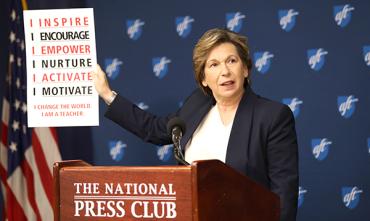The Freedom to Teach
Ask any teacher why she entered the profession, and she’s likely to talk about inspiring and nurturing students, cultivating their potential and promoting joy in learning. Ask her how she feels about teaching today, and you’re likely to get a reaction ranging from exasperation to tears. We are in the midst of a crisis that is destroying the soul of teaching and hollowing out the teaching profession.
Teachers and other school employees are leaving the profession at the highest rate on record—nearly 300,000 each year, two-thirds before retirement age. Enrollment in teacher preparation programs plummeted 38 percent nationally between 2008 and 2015. There were 110,000 fewer teachers than needed in the last school year. All 50 states started the last school year with teacher shortages. And schools serving majorities of students of color and students living in poverty experience the highest teacher turnover rates.
The financial consequences of this constant churn are steep—more than $2 billion annually, according to a conservative estimate. And losing so many educators’ experience and expertise has an enormous negative impact on students’ education.
More than 100,000 classrooms across the country have an instructor who is not credentialed. How many operating rooms do you think are staffed by people without the necessary qualifications? Or airplane cockpits? Why are we doing this to our kids?
This is an alarming and growing crisis. It has two major roots: deep disinvestment from public education and the deprofessionalization of teaching. America must confront both.
The teacher uprisings of the last two years have laid bare the frustration over insufficient resources, deplorable facilities, and inadequate pay and benefits for educators. This disinvestment is often a choice—to cut funds for public schools to finance tax cuts for corporations and the super-rich or to siphon funds for privatization. Twenty-five states spend less on public education than they did a decade ago. Public school facilities got a D+ from the American Society of Civil Engineers. That means thousands of schools are outdated, unsafe, and unfit, and are making people sick. The lack of resources is literally a matter of life and death. A child in Philadelphia died after suffering an asthma attack in a school without a nurse on duty.
In 38 states, teacher salaries are lower than before the Great Recession. Teachers are paid 24 percent less than other college graduates. The stories are all too common of teachers working two or three additional jobs, and even selling their blood plasma, just to get by. They’re getting squeezed in both directions: lower income and higher expenses for things like healthcare and student loans.
Teachers’ dissatisfaction stems not just from underfunding and disgraceful school conditions; they are frustrated and demoralized by deprofessionalization that strips them of their freedom to teach. In recent focus groups, teachers across the country spoke about entering teaching excited, optimistic and determined to make a difference in their students’ lives. And they spoke with equally deep emotion about the stress and disrespect they soon experienced.
It’s things like being told to teach according to a set pacing calendar, even if students need more time. It’s getting in trouble for allowing students to continue a debate over two days, instead of one. It’s being treated as “test preparation managers,” as one teacher put it, and “drowning in a sea of paperwork,” as another said—data collection, data entry and data reporting. And, too often, top-down control trumps all else. That hurts students, and it demoralizes teachers.
It’s not rocket science to see that the United States needs to reverse course. Through the AFT Fund Our Future campaign, teachers throughout the country are fighting for adequate investment in public education—from school levies and sufficient state support to full funding of Title I and the Individuals with Disabilities Education Act.
And we are focusing on things we can legislate and negotiate to make teaching a profession marked by trust, respect and the freedom to teach. That starts by focusing on three essential areas: developing a culture of collaboration in schools and districts, creating and maintaining proper teaching and learning conditions, and ensuring teachers have voice and agency befitting their profession. These are pragmatic actions that schools and districts could start work on tomorrow.
If we want our public schools to be all we hope, if we want to attract and retain a new generation of wonderful teachers to educate the nation’s children, this cannot be solely a teacher issue or a teacher union issue. We must act, and act together.
More information about the crisis in the teaching profession, and how to address it, is at aft.org/freedomtoteach.

